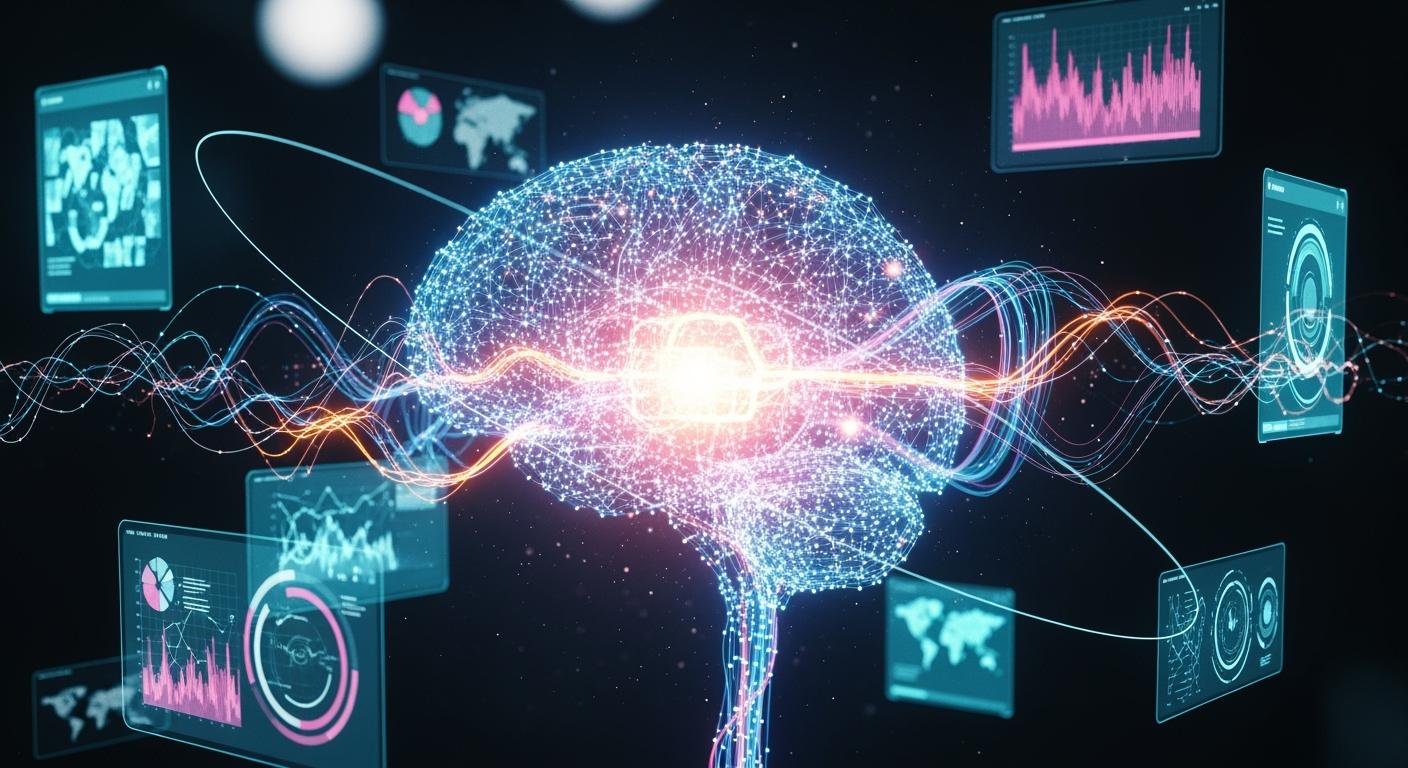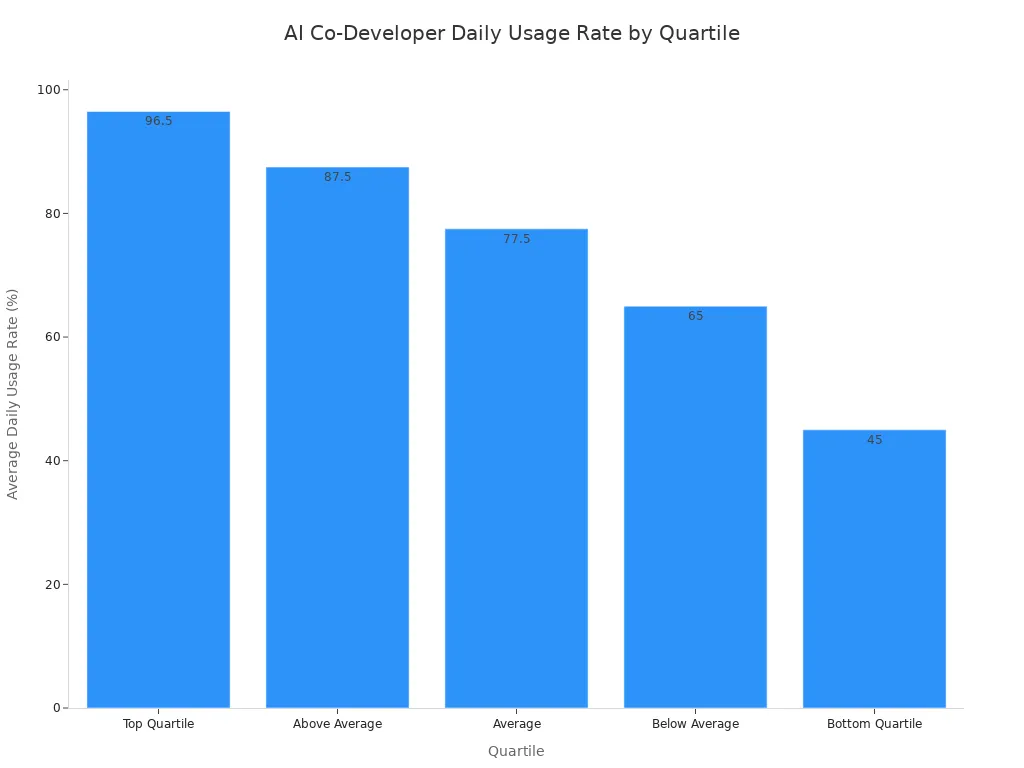
Adaptive AI evolves beyond simple automation. It is now a dynamic partner for real-time decision-making. The significance of current AI trends is clear. The future of AI is shifting toward real-time responsiveness. This new generation of AI systems demonstrates this shift. These powerful AI trends are driving major growth.
The global adaptive AI market is projected to grow from USD 1.04 billion, showing a 40.20% annual growth rate.
Understanding these AI trends is vital for adaptive ai development. The future of AI depends on these artificial intelligence trends.
Trend 1: Proactive Workplace Collaboration with AI

The role of artificial intelligence in the workplace is changing. AI is no longer just a tool for simple automation. It is becoming a proactive partner. These new AI trends show a move toward smarter collaboration. This AI integration is creating more dynamic and efficient work environments.
Beyond Task Automation to Predictive Insights
Modern adaptive ai systems go beyond basic tasks. They now provide predictive insights that guide better decision-making. These systems analyze project data to identify potential risks before they happen. For example, an AI can unify delivery, finance, and personnel data. This allows it to forecast project delays and suggest solutions. Other AI tools summarize complex information for teams.
AI-Powered Summarization Tools
AI Tool Purpose for Teams Salesforce Einstein Generates summaries of customer calls to identify next steps. Discord Summaries Consolidates chat messages into topics for quick understanding. Alteryx Workflow Summary Documents analytic workflows for data analysts.
This shift helps teams move from reactive problem-solving to proactive strategy. These AI trends are key to improving team performance.
Fostering Human-AI Synergy
Human-AI synergy is a major focus of current AI trends. Studies show that collaboration with AI boosts both productivity and work quality. Programmers using AI tools complete tasks faster. Customer service agents show greater creative performance. This synergy allows employees to focus on high-value work. The AI handles the heavy data analytics. This frees up human team members for strategic thinking and making important data-driven decisions. The result is a significant increase in overall productivity and efficiency. Many leaders see the value in these trends. Around 50-52% are now integrating AI into their systems, reporting productivity gains of 25-40%.
Optimizing Workflows and Communication
Companies are using adaptive ai to streamline their operations. These AI systems optimize workflows and improve communication. For instance, Johnson Controls implemented an AI assistant that reduced HR call volume by 30-40%. This allowed the HR team to focus on strategic tasks like employee retention. Similarly, Ciena introduced an AI assistant in Microsoft Teams for 24/7 support. This integration unified workflows and cut down approval times. These powerful systems can automatically:
- Categorize incoming requests.
- Assign tasks based on team member skills.
- Generate summaries of long project threads.
This level of automation drives greater efficiency. It makes adaptive ai a vital part of modern business trends.
Trend 2: The Rise of Smarter Adaptive AI Systems
The future of AI is moving toward more intelligent and autonomous systems. These new AI trends show that adaptive AI is becoming capable of learning and reasoning on its own. This evolution in adaptive AI development is creating powerful tools for many industries, including healthcare. These advanced systems are a key part of current AI trends.
Self-Improving and Reasoning AI
Modern adaptive AI systems are designed for continuous improvement. They possess powerful capabilities that allow them to get smarter over time. This innovation is central to the future of AI.
- Continuous Learning: The systems learn from new data in real time.
- Contextual Understanding: They interpret data based on business goals.
- Real-Time Adaptation: The AI adjusts its actions as conditions change.
- Self-Correction: It identifies and fixes its own errors to improve decision-making.
Unlike older artificial intelligence that just predicted patterns, new reasoning AI systems solve problems logically. Recent AI trends in adaptive AI development show a clear shift. For example, Google DeepMind's AlphaEvolve uses language models to design better algorithms. This type of learning and innovation makes the future of AI very exciting for fields like healthcare.
Introducing Multimodal and Agentic Systems
New AI technologies are also changing how systems interact with data. Multimodal AI systems can process different types of information at once, such as text, images, and audio. This allows for a deeper understanding of complex situations, which is vital for accurate personalization in healthcare.
Agentic AI represents another leap forward. These are goal-oriented systems that can plan and execute tasks without human guidance. An agentic system in healthcare could coordinate with medical teams or manage patient data securely. These adaptive AI systems are highly specialized and collaborative, making them ideal for complex environments like healthcare. This is a core part of adaptive AI development.
Boosting Operational Intelligence
Smarter adaptive AI is transforming how businesses operate. These technologies enhance operational intelligence by making systems proactive instead of reactive. An adaptive AI can analyze real-time data streams to manage supply chains or optimize hospital workflows in healthcare.
By integrating self-learning algorithms and dynamic execution, these systems ensure that the entire operation runs smoothly. They connect different departments, providing a complete view that helps everyone make faster, better decisions.
This level of orchestration is a major goal of adaptive AI development. It drives efficiency and personalization, showing the practical power of these emerging AI trends and the future of AI. The learning capabilities of these systems are critical for industries like healthcare.
Trend 3: AI as a Co-Developer

The role of artificial intelligence in software creation is undergoing a major transformation. AI is evolving from a simple coding assistant into a true development partner. This innovation is one of the most impactful AI trends, changing how developers build, test, and deploy applications. The future of AI in this space points toward deeper collaboration and smarter automation.
The Evolution of AI Coding Assistants
AI coding assistants have moved far beyond basic autocompletion. Early tools saved keystrokes but lacked deep understanding. Modern AI systems now act as reasoning agents. They help plan, write, and even document code. This AI integration is becoming standard practice. Engineering teams show massive adoption, with tools like GitHub Copilot now used by over 1.3 million developers on paid plans. Enterprise adoption is widespread, as AI helps with everything from code generation to debugging.
The average daily usage rate of AI co-developer tools varies by performance, but top-performing developers use them almost every day. This highlights how essential these tools have become.

The Future of Adaptive AI Development
The future of AI in coding involves a more holistic partnership. AI is becoming essential for the entire software lifecycle, especially in testing and debugging. Future adaptive AI systems will autonomously plan test strategies. They will analyze historical defect data to predict risk and optimize test coverage. This proactive approach improves quality and accelerates release cycles. These trends in adaptive AI development are crucial for building resilient and high-quality software. This level of integration makes the development process more efficient and supports better decision-making.
Introducing Intent-Driven Development
A new paradigm called Intent-Driven Development is emerging. This approach makes coding a more intuitive, conversational process. Instead of writing line-by-line instructions, a developer states their goal or "intent." The adaptive AI then translates that intent into functional code.
- A developer describes a feature, like "Add a dark mode toggle."
- The AI generates the necessary code and shows a preview.
- The developer provides feedback to refine the result.
This method transforms coding into a fluid dialogue between human and machine. It represents a significant innovation in adaptive AI development, allowing developers to focus on creative problem-solving. These AI trends are shaping a more collaborative future of AI.
Trend 4: Proactive Governance and Building Trust in AI Trends
The rapid growth of artificial intelligence creates a need for strong governance. These emerging trends show a clear move toward building trust through better regulation. As adaptive ai becomes more powerful, ensuring its responsible use is a top priority. This focus on governance is one of the most important ai trends today.
From Reactive Regulation to Proactive Frameworks
Organizations are shifting from reactive problem-solving to proactive planning. They are building frameworks to guide AI development from the start. Governments are also creating new models for AI regulation. For example, the U.S. developed the AI Risk Management Framework (AI RMF). Canada introduced an Algorithmic Impact Assessment tool. These frameworks promote key principles for responsible AI.
- Transparency: AI decision-making processes should be clear and accessible.
- Accountability: Specific roles must oversee AI compliance and risk.
- Human Oversight: People must be able to review and correct AI decisions.
This proactive approach to regulation helps manage risks before they become problems.
The Global Push for Accountable AI
The demand for accountable AI is a global movement. International groups are creating standards to guide responsible innovation. The OECD AI Principles offer a benchmark for trustworthy AI, influencing policies worldwide. Another major step is the Council of Europe's new treaty on AI. It is the first legally binding international agreement on the topic. This treaty requires that AI systems respect human rights. Such global AI regulation efforts show a united push for safe and ethical technology integration. These trends in regulation are shaping the future of AI.
Balancing Innovation with Ethical Safeguards
Building public trust is essential for AI adoption. Studies show that only 46% of people are willing to trust AI systems. To overcome this, companies must balance innovation with strong ethical rules. The main risks of AI include algorithmic bias and data privacy concerns.
People want assurance over the AI systems they use. AI’s potential can only be fully realized if people trust the systems making decisions or assisting in them.
Organizations can build this trust by establishing clear governance. They must carefully check training data for bias. They also need to ensure their adaptive ai systems are transparent. This balance allows for continued progress while protecting users. It is a critical part of modern AI trends and regulation.
Current AI trends show artificial intelligence becoming a proactive partner, a smarter agent, and a co-developer. New governance guides these powerful technologies. Staying relevant requires a culture of continuous learning and adaptation.
Organizations should responsibly scale their use of adaptive ai. This learning process helps maximize the potential of adaptive ai trends and minimize risks. Embracing these new AI tools is essential for future growth.
FAQ
What is adaptive AI?
Adaptive AI is a type of artificial intelligence. It learns and changes based on new information in real time. The system adapts its behavior without human intervention. This makes it a dynamic and responsive technology for modern business challenges.
How does adaptive AI improve workplace collaboration?
Adaptive AI helps teams by offering predictive insights. It automates complex data analysis and optimizes workflows. This allows employees to focus on high-value strategic tasks.
This synergy between humans and AI boosts overall team productivity and improves decision-making.
What is Intent-Driven Development?
Intent-Driven Development is a new coding approach. A developer states a goal, or "intent," in plain language. The AI then translates that goal into functional code. This process makes software creation a more conversational and intuitive experience.
Why is AI governance so important?
AI governance builds public trust and ensures responsible use. It creates a balance between innovation and safety. Key goals include:
- Preventing algorithmic bias.
- Protecting user data and privacy.
- Ensuring human oversight of AI systems.
See Also
AI's Role in Managing Rapid Viral Trends Within Fast Fashion
Do Your AI Solutions Actively Monitor Social Media Platforms?
Innovative AI-Powered Fashion Solutions for a More Sustainable Planet
Predicting Future Demand Using Artificial Intelligence and Data by 2025
Utilizing AI to Boost Production Forecast Accuracy: 2024 Enterprise Strategies